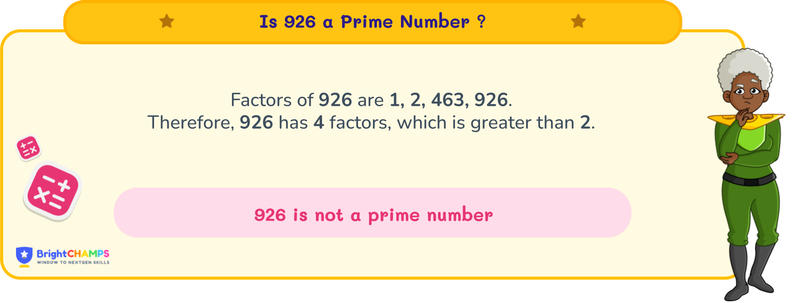Summarize this article:
 160 Learners
160 LearnersLast updated on August 5, 2025
Is 926 a Prime Number?

A prime number is a natural number greater than 1 that has no positive divisors other than 1 and itself. Prime numbers play a significant role in various fields such as cryptography, number theory, and computer science. In this topic, we will explore whether 926 is a prime number.

Is 926 a Prime Number?
There are two main categories for numbers —
prime numbers and composite numbers, determined by the number of factors they have.
A prime number has exactly two distinct positive divisors: 1 and itself.
For example, 5 is a prime number because it is divisible only by 1 and 5.
A composite number has more than two divisors.
For instance, 8 is divisible by 1, 2, 4, and 8, making it a composite number.
Key properties of prime numbers include:
- Prime numbers are greater than 1.
- The only even prime number is 2.
- They have exactly two factors: 1 and the number itself.
- Any two distinct prime numbers are co-prime, meaning they have no common factors other than 1.
- Since 926 has more than two factors, it is not a prime number.


Why is 926 Not a Prime Number?
The defining feature of a prime number is that it has exactly two divisors: 1 and itself. Since 926 has more than two factors, it is not a prime number. To distinguish between prime and composite numbers, several methods can be used, such as:
- Counting Divisors Method
- Divisibility Tests
- Prime Number Chart
- Prime Factorization

Using the Counting Divisors Method
The counting divisors method involves determining the number of divisors a number has to classify it as prime or composite.
- If a number has exactly 2 divisors, it is prime.
- If there are more than 2 divisors, the number is composite.
Let’s determine if 926 is prime or composite.
Step 1: All numbers are divisible by 1 and themselves.
Step 2: Divide 926 by 2. It is divisible by 2, so 2 is a factor of 926.
Step 3: Check divisibility by other numbers up to the square root of 926.
Since 926 has more than 2 divisors, it is a composite number.

Using the Divisibility Test Method
The divisibility test method involves applying specific rules to determine if a number is divisible by another without a remainder.
Divisibility by 2: The last digit of 926 is 6, an even number, so it is divisible by 2.
Divisibility by 3: The sum of the digits in 926 is 17, which is not divisible by 3, so 926 is not divisible by 3.
Divisibility by 5: The last digit is not 0 or 5, so 926 is not divisible by 5.
Divisibility by 7: Applying the divisibility rule for 7, 926 is not divisible by 7.
Since 926 is divisible by 2 among others, it has more than two factors, making it a composite number.

Using Prime Number Chart
The prime number chart uses the "Sieve of Eratosthenes" method to identify prime numbers.
Step 1: Write numbers from 1 to 1000 in a grid.
Step 2: Leave 1 as it is neither prime nor composite.
Step 3: Mark 2 and eliminate its multiples.
Step 4: Mark 3 and eliminate its multiples.
Step 5: Continue marking primes and eliminating multiples. From this process, we find the prime numbers.
Since 926 is not marked as a prime number, it is composite.

Using the Prime Factorization Method
Prime factorization involves breaking down a number into its prime factors.
Step 1: Start with the smallest prime, 2. 926 ÷ 2 = 463.
Step 2: Check if 463 can be broken down further.
Step 3: 463 is a prime number.
Thus, the prime factorization of 926 is 2 × 463.

Common Mistakes to Avoid When Determining if 926 is Not a Prime Number
Misunderstandings about prime numbers can lead to errors. Here are some typical mistakes:

FAQ on is 926 a Prime Number?
1.Is 926 a perfect square?
2.What is the sum of the divisors of 926?
3.What are the factors of 926?
4.What are the closest prime numbers to 926?
5.What is the prime factorization of 926?
6.How can children in Saudi Arabia use numbers in everyday life to understand Is 926 a Prime Number??
7.What are some fun ways kids in Saudi Arabia can practice Is 926 a Prime Number? with numbers?
8.What role do numbers and Is 926 a Prime Number? play in helping children in Saudi Arabia develop problem-solving skills?
9.How can families in Saudi Arabia create number-rich environments to improve Is 926 a Prime Number? skills?

Important Glossaries for "Is 926 a Prime Number"
- Composite numbers: Numbers greater than 1 that have more than two factors. For example, 926 is composite because it is divisible by 1, 2, 463, and 926.
- Prime numbers: Numbers greater than 1 with exactly two distinct positive divisors: 1 and themselves. For example, 463 is a prime number.
- Factors: Numbers that divide another number exactly. For instance, the factors of 6 are 1, 2, 3, and 6.
- Divisibility Test: A method to determine if one number is divisible by another without remainder.
- Prime Factorization: Breaking down a number into its prime factors. For example, the prime factorization of 926 is 2 × 463.

Explore More numbers
![Important Math Links Icon]() Previous to Is 926 a Prime Number?
Previous to Is 926 a Prime Number?
![Important Math Links Icon]() Next to Is 926 a Prime Number?
Next to Is 926 a Prime Number?

About BrightChamps in Saudi Arabia


Hiralee Lalitkumar Makwana
About the Author
Hiralee Lalitkumar Makwana has almost two years of teaching experience. She is a number ninja as she loves numbers. Her interest in numbers can be seen in the way she cracks math puzzles and hidden patterns.
Fun Fact
: She loves to read number jokes and games.




